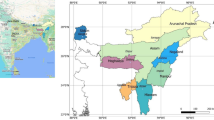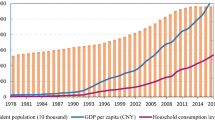Abstract
This paper illustrates an overview of the past and present MSWM strategies in China. A comparison is made with MSWM in China, and other developed and developing countries to identify and analyze the problems of existing MSWM, and evaluate some effective suggestion to overcome the limitations. Rapid urbanization and economic growth are the main factors of increasing MSW generation in China. The generating MSW has 55.86 % food waste with high moisture contain due to unavailable source separation. Chinese MSWM is dominated by 60.16 % landfilling, whereas incineration, untreated discharge, and other treatments are 29.84, 8.21, and 1.79 %, respectively. In 2014, a total of 604 sanitary landfills, 188 incineration plants, and 26 other units were used for MSWM. With the magnitude of timing, the increasing rate of incineration unit and disposal capacity is higher than the landfill. In 2004–2014, the disposal capacity of landfill and incineration is increased from 68.89 to 107.44 and 4.49 to 53.3 million tons, respectively. However, the heating value in the majority of Chinese incineration plants is 3000–6700 kJ/kg and the inappropriate leachate treatment can be found in 47 % landfill sites. A proper taxation system for MSW disposal is not fully implemented in China, which has a negative impact on overall MSW recycling. From the comparative study of MSWM, it is revealed that the source separation MSW collection, high energy recovery from incineration plants, appropriate leachate treatment, effective landfill location and management, increase waste recycling and proper taxation system for MSW disposal are essential to improve MSWM in China.




Similar content being viewed by others
References
Hoornweg D, Bhada-Tata P (2012) What a waste: a global review of solid waste management. World Bank, Washington, DC. ©World Bank
World Bank (2005) Waste management in china: issues and recommendations. http://documents.worldbank.org/curated/en/2005/05/6679942/waste-management-china-issues-recommendations. Accessed 5 May 2005
State Environmental Protection Association, Beijing (2006) Report on the development of environmental service industry. http://www.zhb.gov.cn/tech/ghzc/200710/P020071022367639506984.pdf. Retrieved Oct 2008
National Bureau of Statistics of China (2015) Annual data. http://www.stats.gov.cn/tjsj/ndsj/2015/indexch.htm. Accessed 4 Feb 2016
Huang QF, Wang Q, Dong L, Xi B (2006) The current situation of solid waste management in China. J Mater Cycles Waste Manage 8:63–69
Ma JT, Lin XY, Luo L, Zhang WM, Xu YF, Xie HG, Xu XC, Li Q, Li XC (2009) China statistical yearbook. National Bureau of Statistics of China. China Statistics Press. http://www.stats.gov.cn/tjsj/ndsj/2009/indexeh. Accessed 21 March 2011
Zhuang Y, Wu SW, Wang YL, Wu WX, Chen YX (2008) Source separation of household waste: a case study in China. Waste Manag 28:2022–2030
Zhou H, Meng AH, Long YQ, Li QH, Zhang YG (2014) An overview of characteristics of municipal solid waste fuel in China: physical, chemical composition and heating value. Renew Sustain Energy Rev 36:107–122
Hoornweg D, Lam P, Chaudhry M (2005) Waste management in China: issues and recommendations. East Asia Infrastructure Development, The World Bank, Washington, DC, USA
Xiao Y, Bai X, Ouyang Z (2007) The composition, trend and impact of urban solid waste in Beijing. Environ Monit Assess 135:21–30
Ministry of Environment, Government of Republic of Korea (2009) Current status of waste generation and treatment (in Korean)
Robinson A, Sewell GC, Wu S, Damodaran N, Kalas Adams N (2003) Landfill data From China: addressing information needs for methane recovery. Environmental Protection Agency, US
Raninger B (2009) Management and Utilization of municipal and agri-cultural bioorganic waste in Europe and China. Workshop in School of Civil Environmental Engineering. Nanyang Technological University, Singapore
Wang H, Nie Y (2001) Remedial strategies for municipal solid waste management in China. J Air Waste Manag Assoc 51(2):264–272
Habil P, Raninger B (2007) Renewable energy for rural areas in China. GTZ Training, ICEEE, Shenyang
Kusterer T, Willson R, Bruce SC, Tissue E, Lau PJ (1998) Municipal landfill leachate management. Environ Prog 17(4):278–284
Xu WL, Li JH, Higuchi S (2006) Review and forecast on MSW treatment and landfill technology in China. http://www.cis.fukuokau.ac.jp/~higuchis/research/h18/H18.happyou%201.pdf. Accessed 8 May 2011
Yuan H, Wang L, Su F, Hu G (2006) Urban solid waste management in Chongqing: challenge and opportunities. Waste Manag 26:1052–1062
Eurostat (2012) Waste database municipal waste. http://epp.eurostat.ec.europa.eu/portal/page/portal/statistics/search_database. Accessed May 2012
Zhang DQ, Tan SK (2010) Municipal solid waste management in China: status, problems and challenges. J Environ Manage 91:1623–1633
Wu C (2007) Overview of the negative side of the incineration
Zhao P, Ni G, Jiang Y, Chen L, Chen M, Meng Y (2010) Destruction of inorganic municipal solid waste incinerator fly ash in a DC arc plasma furnace. J Hazard Mater 181:580–585
Tian H, Gao J, Lu L, Zhao D, Cheng K, Qiu P (2012) Temporal trends and spatial variation characteristics of hazardous air pollutant emission inventory from municipal solid waste incineration in China. Environ Sci Technol 46:10364–10371
Cheng H, Zhang Y, Meng A, Li Q (2007) Municipal solid waste fueled power generation in china: a case study of waste-to-energy in Changchun city. Environ Sci Technol 41:7509–7515
Cheng H, Hu Y (2010) Municipal solid waste (MSW) as a renewable source of energy: current and future practices in China. Bioresour Technol 101:3816–3824
Zhou J, Wua S, Pan Y, Su Y, Yang L, Zhao J, Lu Y, Xu Y, Oh K, Qian G (2015) Mercury in municipal solids waste incineration (MSWI) fly ash in China: chemical speciation and risk assessment. Fuel 158:619–624
Pan Y, Wu Z, Zhou J, Zhao J, Ruan X, Liu J, Qian G (2013) Chemical characteristics and risk assessment of typical municipal solid waste incineration (MSWI) fly ash in China. J Hazard Mater 261:269–276
Karagiannidis A, Kontogianni S, Logothetis D (2013) Classification and categorization of treatment methods for ash generated by municipal solid waste incineration: a case for the 2 greater metropolitan regions of Greece. Waste Manage 33:363–372
Yang GC, Chen SY (1996) Statistical analysis of physicochemical properties ofmonoliths solidified from a municipal incinerator fly ash. J Hazard Mater 45(2–3):149–173
Andac M, Glasser FP (1998) The effect of test conditions on the leaching of stabilized MSWI-fly ash in portland cement. Waste Manage 18:309–316
Alba N, Va´ızquez E, Gasso´I S, Baldasano JM (2001) Stabilization/solidification of msw incineration residues from facilities with different air pollution control systems. Durability of matrices versus carbonation. Waste Manage 21(4):313–323
Sakai S, Hiraoka M (2000) Municipal solid waste incinerator residue recycling by thermal processes. Waste Manage 20(2–3):249–258
Kuo YM, Lin TC, Tsai PJ (2004) Metal behavior during vitrification of incinerator ash in a coke bed furnace. J Hazard Mater 109(1–3):79–84
Wey MY, Liu KY, Tsai TH, Chou JT (2006) Thermal treatment of the fly ash from municipal solid waste incinerator with rotary kiln. J Hazard Mater 137(2):981–989
Hong KJ, Tokunaga S, Kajiuchi T (2000) Extraction of heavy metals from MSW incinerator fly ashes by chelating agents. J Hazard Mater B75:57–73
Katsuura H, Inoue T, Hiraoka M, Sakai S (1996) Full-scale plant study on fly ash treatment by the acid extraction process. Waste Manage 16:491–499
MoHURD (2010) Ministry of housing and urban-rural development. China urban construction statistical yearbook 2009. China Architecture and Building Press, Beijing
Nie Y (2008) Development and prospects of municipal solid waste (MSW) incineration in China. Front Environ Sci Eng China 2:1–7
Xu X, Liu J (2007) Status and development prospect on municipal solid waste incineration technology in our country. Zhongguo Huanbao Chanye 11:24–29
Chen Y (2009) Yingxu Chen-member of the National Committee of CPPCC (Chinese People’s Political Consultative Conference), Zhejiang University
Liu ZQ, Liu ZH, Li XL (2006) Status and prospect of the application of municipal solid waste incineration in China. Appl Therm Eng 26:1193–1197
Solenthaler B, Bunge R (2006) Waste incineration in China. HSR Hochschule fuer Technik, Rapperswil, Swiss, Institut fuer angewandte Umwelttechnik. Institute for Applied Environmental Technology
Zerbock O (2003) Urban solid waste management: waste reduction in developing nations. Written for the Requirements of CE 5993 Field Engineering in the Developing World. Michigan Technological University
Patumsawad S, Cliffe KR (2002) Experimental study on fluidised bed combustion of high moisture municipal solid waste. Energy Convers Manage 43:2329–2340
Thipse SS, Sheng C, Booty MR, Magee RS, Dreizin EL (2001) Synthetic fuel for imitation of municipal solid waste in experimental studies of waste incineration. Chemosphere 4:1071–1077
Good Practice Guidance and Uncertainty Management in National Greenhouse Gas Inventories (2002) Institute for Global Environmental Strategies (IGES). http://www.ipcc-nggip.iges.or.jp/public/gp/bgp/5_3_Waste_Incineration.pdf. pp 457
Eurostat (2010) Waste database municipal waste. http://epp.eurostat.ec.europa.eu/portal/page/portal/statistics/search_database
National Environment Agency (NEA) Singapore (2011) http://app2.nea.gov.sg/index.aspx
Wong K (2013) Hong Kong blueprint for sustainable use of resources. Hong Kong environmental bureau
Solid Waste and Emergency Response (5306P) Washington DC 20460 (2012) Municipal solid waste generation, recycling, and disposal in the United States. United States Environmental Protection Agency
Cherdsatirkul C (2012) Generation and disposition of municipal solid waste (MSW) management in Thailand. Earth Engineering Center, Columbia University
Author information
Authors and Affiliations
Corresponding author
Rights and permissions
About this article
Cite this article
Mian, M.M., Zeng, X., Nasry, A.a.N.B. et al. Municipal solid waste management in China: a comparative analysis. J Mater Cycles Waste Manag 19, 1127–1135 (2017). https://doi.org/10.1007/s10163-016-0509-9
Received:
Accepted:
Published:
Issue Date:
DOI: https://doi.org/10.1007/s10163-016-0509-9




